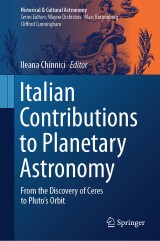Details

Italian Contributions to Planetary Astronomy
From the Discovery of Ceres to Pluto's OrbitHistorical & Cultural Astronomy
|
106,99 € |
|
| Verlag: | Springer |
| Format: | |
| Veröffentl.: | 21.03.2024 |
| ISBN/EAN: | 9783031483899 |
| Sprache: | englisch |
Dieses eBook enthält ein Wasserzeichen.
Beschreibungen
This book describes the most important contributions of Italian astronomers to the development of planetary astronomy during the nineteenth century and the early part of the twentieth century. This journey through what may be regarded as the golden era of Italian astronomy commences with the discovery of Ceres, the first asteroid, now classified as a dwarf planet, and culminates in the role played by the Padua Observatory in calculating Pluto’s orbit in the 1930s. Along the way, a wealth of information is provided on the discovery of many comets and asteroids, early spectroscopic observations, drawings of planets and comets, calculations of orbits and ephemerides, and much more. The contributions of such famous figures as Giovanni Schiaparelli, Giovanni Battista Donati, Angelo Secchi, and Annibale De Gasparis are fully explained. Many of the described results are still of interest for modern astronomy, and the book appeals to a wide readership, including scholars, historians, astronomers, and the general public.<br>
<p>1. A look back to Galileo by Giorgio Strano.- 2. The discovery of Ceres, a sort of “scientific comedy” by Ileana Chinnici.- 3. Schiaparelli’s studies about Mars, asteroids and shooting stars by Mario Carpino and Agnese Mandrino.- 4. Comet observers in Florence by Simone Bianchi, Daniele Galli and Antonella Gasperini.- 5. Angelo Secchi and planetary astronomy by Aldo Altamore, William Sheehan and Richard McKim.- 6. Transit of Venus 1874: an Italian expedition to Bengal by Giuseppe Massone.- 7. De Gasparis’ asteroids by Mauro Gargano.- 8. Catania Observatory and Eros parallax by Gianfranco Occhipinti.- 9. The last “Italian” asteroids by Giuseppe Massone.- 10. Pluto’s orbit: the Paduan contribution by Valeria Zanini and Simone Zaggia. </p>
<div><p>Ileana Chinnici is a research astronomer at the INAF/Palermo Astronomical Observatory, where she is in charge of research work in history of astronomy and museum activities. She graduated in Physics from the University of Palermo, Italy, in 1992 and subsequently undertook a one-year scholarship from Palermo University for the purpose of specialization, working on the archives of the “Carte du Ciel” at the Paris Observatory. A fellowship from the Italian National Research Council (C.N.R.) at Palermo Astronomical Observatory followed where she researched the development of astrophysics in Italy in the second half of the nineteenth century. In 1996, she took up the position of Curator at the Museum of Astronomy, Palermo Astronomical Observatory, working on nineteenth-century astronomical instruments. In the past, she has taught History of Astronomy at Palermo University. In 2004 she obtained the position of research astronomer. From 2010 to 2010, she was a member of the Italian Astronomical Society (SAIt) Council, and since 2003, a member of the International Astronomical Union (IAU) Commission 41 (History of Astronomy) “Archives” Working Group. She is an elected member of the Organizing Committee of IAU Commission 3 (History of Astronomy) for the period 2018 to 2021. She is author of books and papers mainly focused on history of astronomy and astrophysics in the 19th century. For her works, she has received prestigious awards (Osterbrock Book Prize 2021).<br></p></div>
<p>This book describes the most important contributions of Italian astronomers to the development of planetary astronomy during the nineteenth century and the early part of the twentieth century. This journey through what may be regarded as the golden era of Italian astronomy commences with the discovery of Ceres, the first asteroid, now classified as a dwarf planet, and culminates in the role played by the Padua Observatory in calculating Pluto’s orbit in the 1930s. Along the way, a wealth of information is provided on the discovery of many comets and asteroids, early spectroscopic observations, drawings of planets and comets, calculations of orbits and ephemerides, and much more. The contributions of such famous figures as Giovanni Schiaparelli, Giovanni Battista Donati, Angelo Secchi, and Annibale De Gasparis are fully explained. Many of the described results are still of interest for modern astronomy, and the book appeals to a wide readership, including scholars, historians, astronomers, and the general public.</p><p></p>
Covers many important discoveries and observations Describes research results of relevance for current research Written to appeal to both professionals and the wider public

















